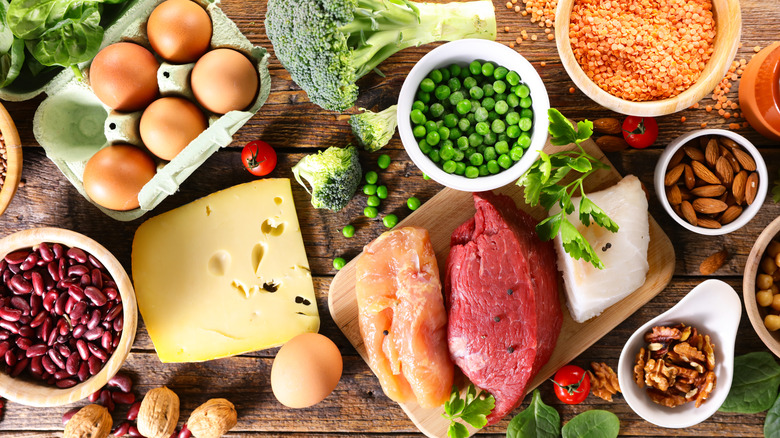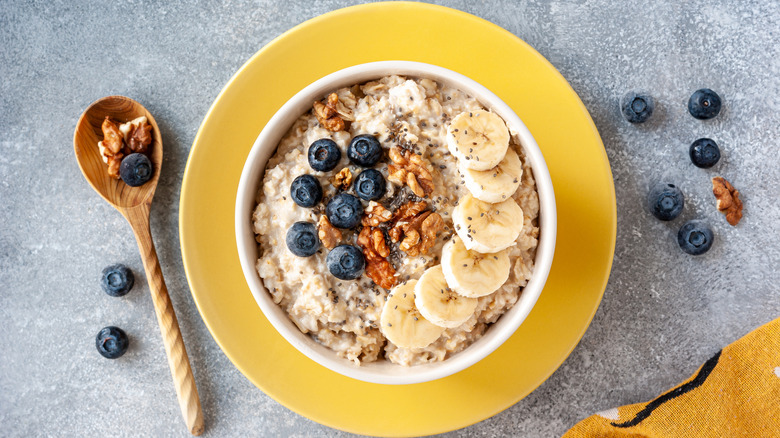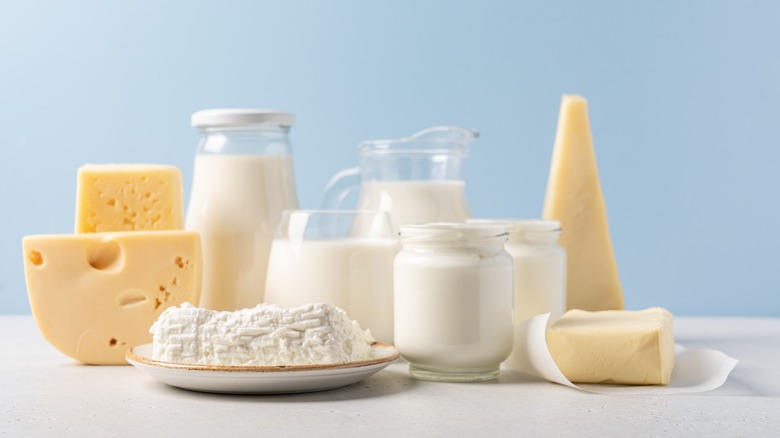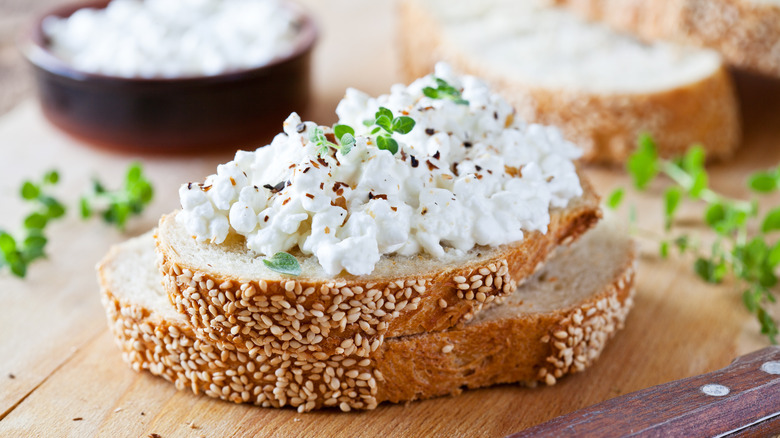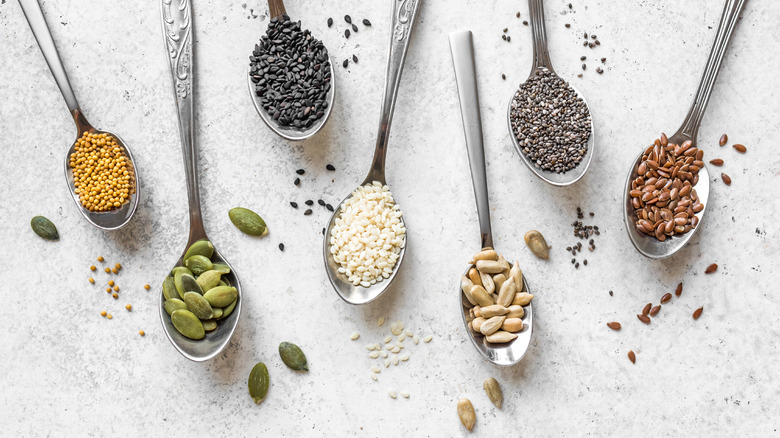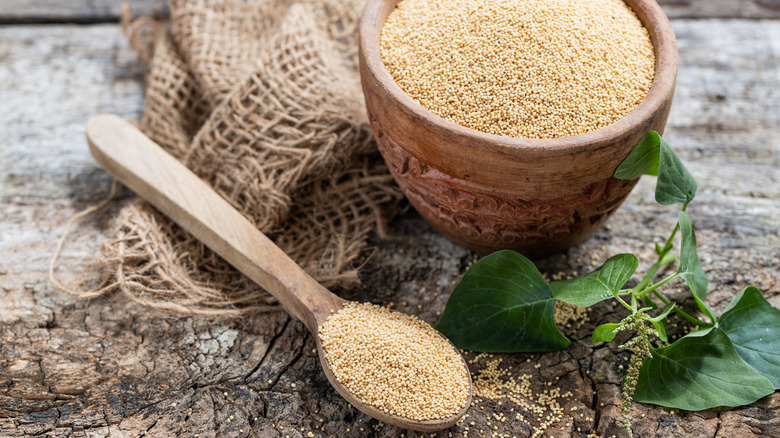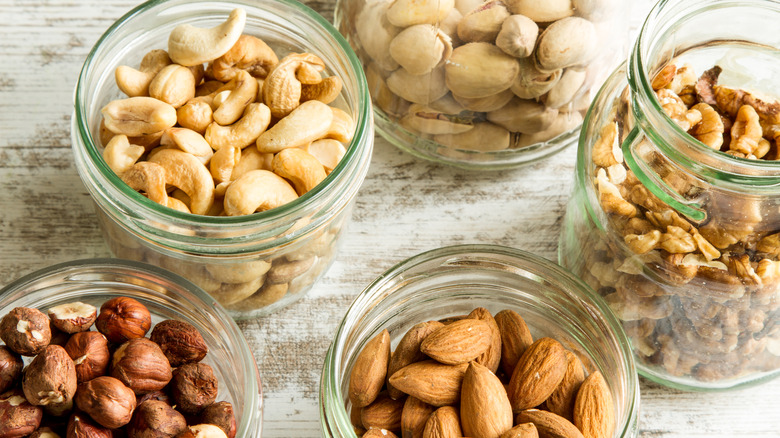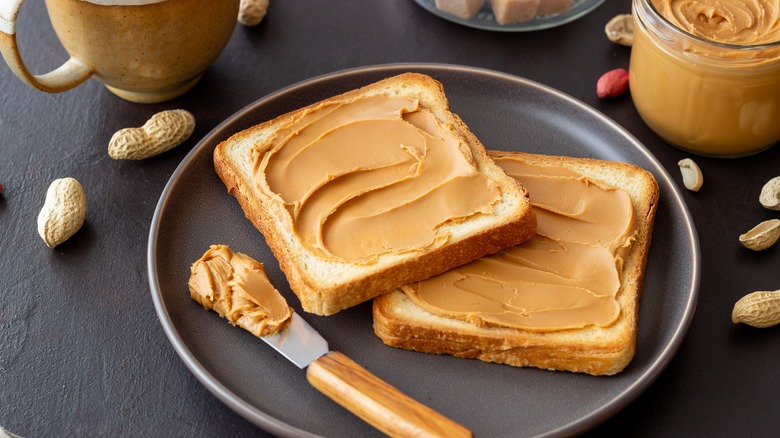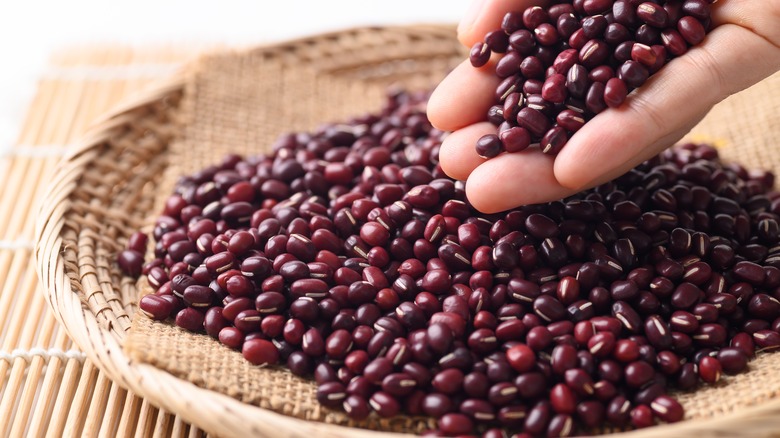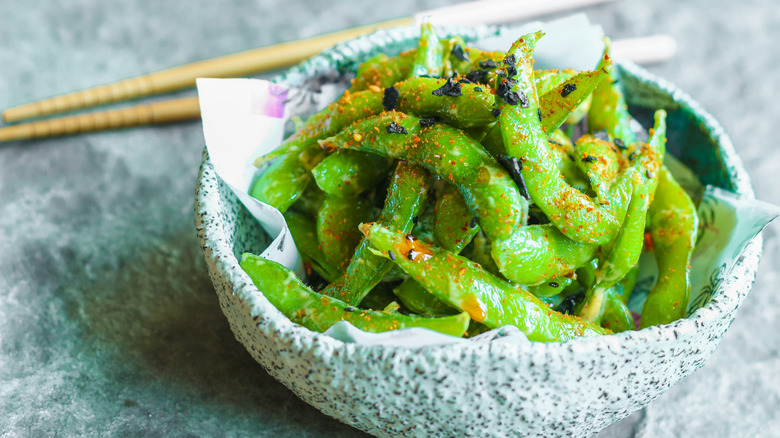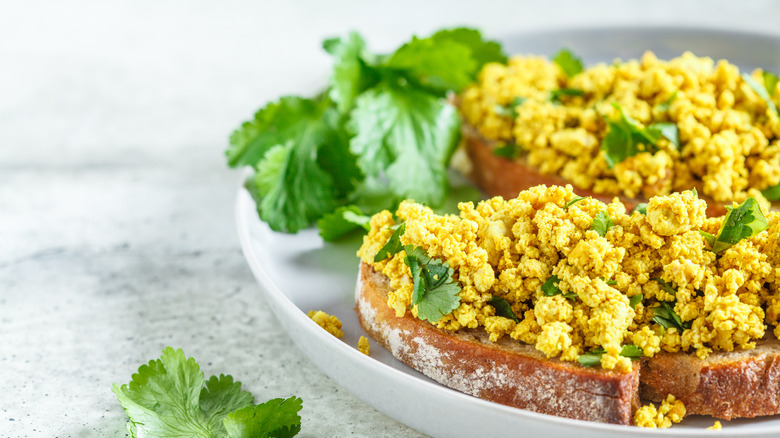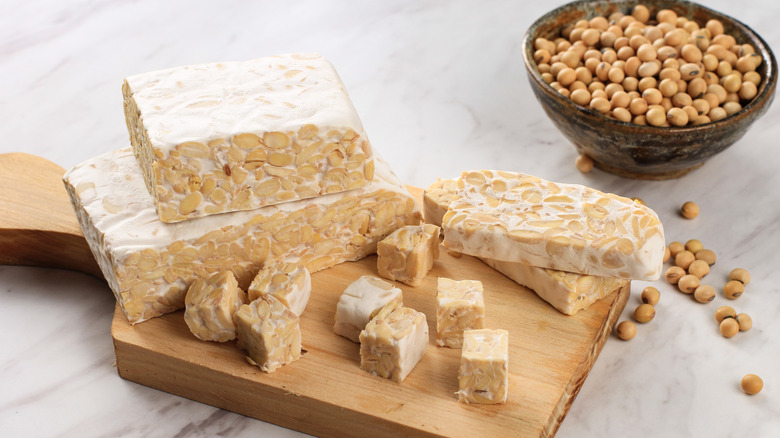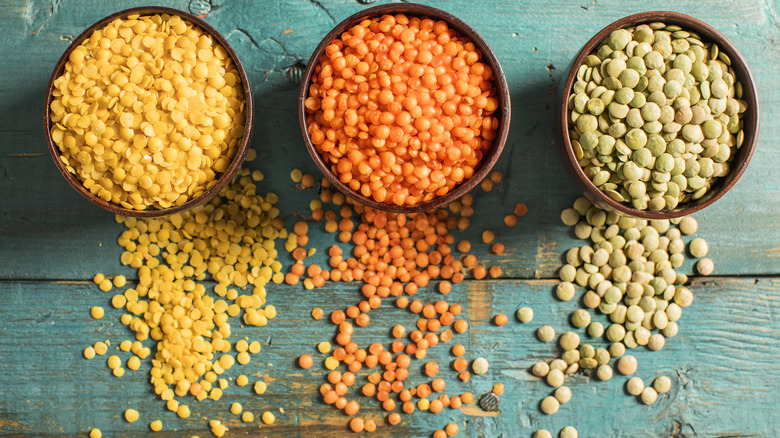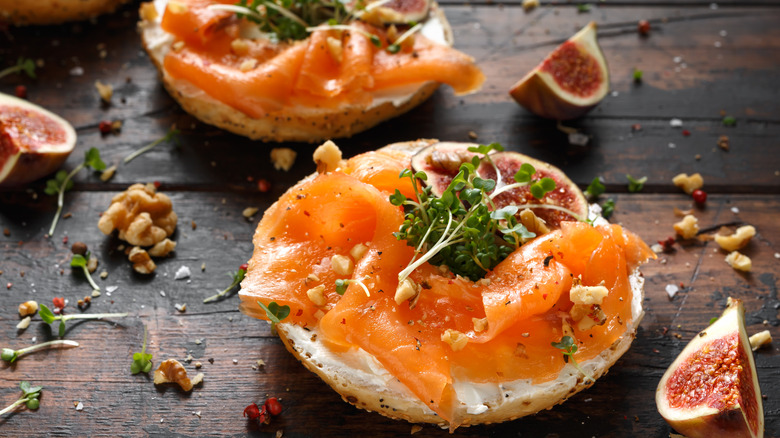14 Alternatives To Eggs For A Protein-Rich Breakfast
Whether scrambled, hard-boiled, poached, or sunny side up, eggs have a long history as a breakfast staple. Lauded for their versatility, accessibility, and high protein content, the humble egg has become an icon of the morning meal. Healthline calls eggs one of the healthiest foods on the planet, providing a range of essential nutrients, including high-quality protein, a macronutrient critical to human life. Made up of building blocks called amino acids, protein carries out numerous functions in the human body from repairing and making new cells to protecting against disease and curbing hunger. According to the Harvard School of Public Health, it is recommended that adults consume just over 7 grams of protein for every 20 pounds of body weight. One egg contains approximately 6 grams of protein and contains all of the essential amino acids the human body needs.
With shortages and rising egg prices affecting much of the country, Americans might find themselves in search of alternative sources of protein to start their day. In addition to inflation influencing the grocery list, plant-based proteins are increasing in popularity with individuals incorporating more vegan or plant-focused meals into their lifestyles. Whether you are looking for budget-friendly options or searching for fresh ideas for changing up your breakfast routine, try these alternatives to eggs for a protein-rich breakfast.
Oatmeal
A breakfast staple nearly as iconic as the egg, oatmeal is an affordable, versatile, and nutritious option for your morning meal. Oats are a low-cost protein with good nutritional value as it contains a healthy balance of quality protein, fiber, and complex carbohydrates. From old-fashioned to steel cut, the vegan, gluten-free grain is a cost-efficient way to bulk up your protein at breakfast and keep you feeling full until lunch. According to the USDA, a ½ cup serving of oats contains more than 5 grams of protein, only slightly less than one egg.
There are many ways to enjoy oats for breakfast ranging from savory to sweet. A bowl of oatmeal topped with your favorite ingredients is perfect for warming up on cool mornings. You can even boost your protein intake even more by mixing in other protein-rich foods like yogurt and nut butter or add texture with a crunchy granola made of nuts and seeds. Overnight oats are a convenient breakfast option for rushed mornings, or you can transform oats into quick, grab-and-go breakfast cookies, muffins, and other baked goods. Blitz some oats into flour to infuse extra protein into bread, pastries, waffles, and pancakes.
Dairy
From milk to yogurt to cheese, there are dozens of ways to incorporate dairy into your morning meal. In addition to important nutrients such as calcium and vitamin D, dairy products provide a hefty helping of protein with a cup of skim milk carrying up to 8 grams, 1.5 ounces of cheddar cheese of about 10 grams, and 6 ounces of Greek low-fat yogurt a whopping 17 grams of protein (via Undeniably Dairy). With a diverse range of flavors and textures, dairy products are one of the most adaptable ingredients for breakfast. Boost your smoothies with a few dollops of Greek yogurt, build a fruity parfait, mix some milk into oatmeal, make buttermilk pancakes, bake a cheesy casserole, and more.
A glass of milk is an easy way to add a few extra grams of protein to your morning, but those interested in exploring other types of dairy might consider unique, protein-rich dairy products from around the world such as kefir or quark. Kefir is a nutrient-dense, fermented dairy product from Eastern Europe and Asia with acidic, mild flavors and liquid texture. A 1-cup serving offers about 9 grams of protein (via Healthline). Quark is a soft cheese commonly eaten across Europe with a smooth, yogurt texture and flavor similar to sour cream. With 11 grams of protein per half cup, quark is a nutritious swap for ingredients such as regular yogurt or heavy cream in smoothies, sauces, casseroles, and more.
Cottage cheese
Although milk and yogurt can add considerable protein to your morning meal, cottage cheese is the real protein powerhouse of the dairy world. Peaking in popularity in the mid-20th century, cottage cheese can be a polarizing ingredient with its chunky, creamy texture and slightly sour taste. Classically eaten with sliced peaches or tomatoes, cottage cheese is a surprisingly diverse ingredient that is packed with protein and vitamins. We implore giving cottage cheese a second look as it eclipses the protein of an egg with up to 19 grams in a 5.3-ounce serving. The mild flavor lends itself to both sweet and savory applications, offering a diverse range of nutritious combinations for breakfast.
Try a scoop of cottage cheese on toast topped with a classic fruit and nut pairing such as walnuts and figs or a Southwest-inspired combination of black beans and salsa. If the curds are a textural turn-off, simply blend the mixture until smooth to spread on a wrap or stir into a smoothie. Take a cue from traditional Eastern European cooking and add cottage cheese or ricotta to your pancakes, fritters, and pastries.
Seeds
Seeds are small, but mighty when it comes to nutrient-rich ingredients for infusing high-quality protein at breakfast. Rich in healthy fats, fiber, vitamins, and minerals, seeds bring a wealth of nutritious benefits wrapped in a tiny package. Cleveland Clinic names flax, chia, pumpkin, sunflower, hemp, and sesame as the best seeds to include in your diet, but when it comes to protein, two stand out above the rest: hemp and chia.
Chia seeds are a fascinating source of plant-based protein, with one serving containing about 5 grams, as well as fiber, omega-3 fatty acids, vitamins, minerals, and antioxidants. They can absorb multiple times their weight in liquid, creating a unique, gelatinous texture that makes them an excellent vegan alternative to eggs in baked goods. Chia seeds are also a popular addition to puddings, oatmeal, smoothies, crackers, and granola bars. Hemp seeds are the highest seeds in protein with over 9 grams per serving, and they are rich in heart-healthy minerals and essential fatty acids. Hemp seeds are a protein-rich addition to smoothies, yogurt, cereal, oatmeal, granola, and homemade protein bars.
Amaranth
Although often included with the illustrious ancient grains, the small, couscous-like amaranth is actually a seed. Straddling the line between seed and grain, the nutrient profile of amaranth includes a diverse range of vitamins and minerals in addition to the most protein of any grain at 9 grams per cup. It has a mild, nutty flavor and can be consumed whole or ground into flour.
Despite just beginning to gain traction in the United States around the 1970s, amaranth has long been a popular ingredient in other global cuisines from India to Mexico. The unique seed was believed to have been cultivated by the Aztecs up to 8,000 years ago. Preparing amaranth is similar to rice or quinoa, making it an easy, make-ahead option for protein-rich breakfasts. Try including this nutritious grain in breakfast bowls or burritos or grind the amaranth into flour to boost the protein in your pancakes, waffles, bread, and baked goods.
Tree nuts
An easy and satisfying snack on their own, tree nuts make an excellent, protein-rich addition to breakfast. As listed by the American Academy of Allergy, Asthma, & Immunology, tree nuts include almonds, Brazil nuts, cashews, hazelnuts, pecans, pistachios, and walnuts. If you are fortunate enough to not have an allergy to these nuts, they can provide a wealth of benefits to your diet. Ranging from 4-7 grams of protein per quarter cup, tree nuts are also rich in healthy fats, fiber, and a variety of other essential nutrients (via Healthline).
Adding texture, crunch, and a nutty flavor, tree nuts complement soft or creamy dishes like oatmeal and yogurt. They can bulk up granola and protein bars or be transformed into nut butter to spread on toast, mix into smoothies, or drizzle over fruit. With their fatty texture, walnuts have found a place among plant-based substitutes for ground meat. Seasoned with bold spices and ground into a meaty texture, walnuts can even make a tasty, protein-rich filling for breakfast tacos or burritos.
Peanut butter
Peanut butter is a staple breakfast food whether simply spread over toast, blended into a smoothie, or drizzled over oatmeal. Although also high in calories, peanuts have the distinction of carrying the most protein of the nuts at over 9 grams per quarter cup, according to the USDA. Despite their caloric density, peanuts and peanut butter are nutrient-rich sources of protein that comes with important vitamins and minerals such as phosphorus, potassium, zinc, folate, and vitamin E.
Beyond the iconic peanut butter and jelly, there are tons of ways to use peanut butter for breakfast and throughout the day. Incorporate peanut butter into homemade granola bars, banana bread, or make-ahead breakfast cookies. Add some protein to a decadent French toast or smear some peanut butter over pancakes, waffles, or crepes. You can also make a quick and easy meal out of the classic combination of peanut butter and bananas for a nutritious start to the day.
Beans
With dozens of types of beans to choose from each with its own unique textures and flavors, beans are an incredibly diverse and nutritious protein source to consider swapping into your diet. The Bean Institute reports that most bean varieties average about 8 grams of protein per ½-cup serving. From cannellini beans to pintos, dried or canned legumes are an accessible, affordable, sustainable, and long-lasting pantry staple that has become a go-to ingredient for everyone from vegetarians or vegans to backpackers and survivalists. Despite the many nutritional benefits including high rankings in protein and fiber, beans have been known to cause some gastrointestinal distress if eaten in volume, and canned beans are notoriously high in sodium.
Black beans are an important ingredient across many Latin American cuisines as well as Cajun and Creole dishes, Cuban food, and Tex-Mex cooking. The tender, mildly flavored beans have also made their way as a healthy swap into baked goods such as brownies. For breakfast, consider adding black beans into a Southwest-inspired breakfast burrito or over a classic Mexican morning meal like chilaquiles. Beans don't have to be limited to savory dishes, either. Adzuki, or azuki beans, also known as red beans, are a popular legume found across East Asia and the base for the sweet red bean paste commonly used as a filling for numerous Asian pastries and sweets. Try a dollop of red bean paste with your oatmeal or spread it over some toast or a morning pastry.
Edamame
Often relegated to a sushi night appetizer, edamame is a versatile, protein-packed legume with 6 grams per ½-cup serving. In addition to protein and fiber, immature green soybeans are a great source of vitamin C, calcium, iron, and folates (via WebMD). Widely found throughout various Asian cuisines, edamame is often sold either shelled or in its pod in the frozen section of Western grocery stores. Note that edamame pods are not meant to be eaten, although they are sometimes seasoned and served whole for diners to extract the tender beans during the meal. Edamame is typically eaten on its own as a snack or incorporated into rice dishes, stir-fries, salads, and soups.
Working protein-rich edamame into your breakfast is probably easier than you think. With just a hint of buttery sweetness and nuttiness, edamame is a mild-flavored ingredient that pairs well with a variety of foods. The bright green soybeans can be enjoyed simply with a dash of salt as an easy breakfast side, lightly mashed or sprinkled whole over avocado toast, or rolled up in a breakfast burrito for an extra protein punch. The tender beans can also be pureed into a robust pesto for a bold breakfast sandwich or blended into a satisfying green smoothie.
Tofu
Perhaps the most iconic vegan protein, tofu is a go-to alternative to eggs for a protein-rich breakfast. Tofu is made by a centuries-old process of grinding soybeans and water into milk infused with calcium and magnesium salt which then coagulates into soft curds that are shaped into the familiar blocks found in the grocery store today. Available in a variety of textures from silken to extra firm, tofu is a versatile ingredient that acts like a sponge, soaking in whatever flavors are added to it. The American Heart Association touts the benefits of tofu with up to 21 grams of protein in a ½-cup serving as well as healthy fats and essential vitamins and minerals.
Beyond the classic tofu scramble, which can be enjoyed in place of eggs on a classic breakfast plate or added to breakfast bowls, tacos, burritos, and more, there are numerous ways to use tofu at breakfast. Improve the nutrient content and texture of a smoothie by blending in some silken tofu along with your fruits and vegetables. You can also use tofu as an egg substitute in baking, adding a protein boost to your morning muffin. Blend tofu into a plant-based spread similar to cream cheese that can be made sweet or savory to top bagels and breakfast sandwiches. Fried, seasoned tofu cubes can also provide texture and protein served as part of a hearty breakfast bowl or in a vegan riff of chicken and waffles.
Tempeh
A cousin of tofu, tempeh is a soy-based product native to Indonesia made from soybeans that are left to ferment until they solidify into a cake-like structure. Sometimes other grains or seeds are added to the mixture to further improve the nutrient profile. Boasting even more protein than tofu, tempeh offers approximately 15 grams in a 3-ounce serving, according to Healthline. In addition to its high protein content, tempeh carries a host of nutritional benefits from supporting gut health to managing cholesterol. Unlike tofu, tempeh tends to have a stronger, nutty flavor and a much firmer texture.
Tempeh can be sliced and seasoned to accommodate a variety of flavors. It takes well to marinades and sauces and holds up to bold seasonings. Seasoned with a combination of sweet, savory, and smoky spices, tempeh bacon or sausage has become a popular alternative to pork bacon. Mimicking the texture of meat, tempeh can also be seasoned and crumbled in a range of savory breakfast dishes such as potato hash, breakfast burritos, and hearty casseroles.
Lentils
Colorful lentils are the world's oldest cultivated legume and a staple in cuisines across the globe from India and the Middle East to Europe and the Americas. Similar to beans, lentils are pulses, which refer to the dried seeds of legumes, and they are one of the most eco-friendly foods on the planet. They come in an array of shapes, sizes, and colors and offer a wide range of nutritional benefits. A ½ cup serving of lentils contains around 9 grams of protein and 8 grams of fiber, as well as energizing complex carbohydrates, and essential vitamins and minerals.
Much like walnuts or tofu, brown and green lentils, which hold their shape better than the red or yellow varieties, are an excellent alternative to meat crumbles in dishes like breakfast tacos, burritos, and hash. An incredibly diverse protein, lentils can also be toasted for a crunchy element to add to granola bars or pureed into baked goods. They can be formed into plant-based versions of a sausage patty or transformed into a chunky, flavorful spread for breakfast wraps or sandwiches. Swapping animal products like meat and eggs for plant-based alternatives like tofu, tempeh, beans, or lentils benefits both your body and the environment. United Nations University reports that diverse diets that focus less on meat and animal proteins are better for individual longevity as well as protecting the health of the environment and our ability to feed a growing population.
Fish
Although it may not be the first thing that comes to mind when you think of breakfast, fish has a long history as part of the morning meal. From an iconic bagel with lox from the corner deli to a Southern-style plate of shrimp and grits, seafood has held its own at the breakfast table. Kippers, a term for split, pickled, and smoked herring are a classic breakfast food in Britain, while mackerel and salmon appear at morning meals in Japan. Speaking to Men's Journal, registered dietitian Manuel Vilacorta highlighted the top picks for seafood proteins. Wild salmon secured the top spot with 38 grams of complete protein in a 6-ounce serving along with healthy fats and important vitamins and minerals. Farmed trout took second place, followed by wild or canned sardines, farmed tuna, and wild mackerel rounding out the top five.
Upon reviewing relevant research from the American Heart Association and others, Harvard School of Public Health suggests consuming fish twice a week based on the known or likely benefits such as supporting the heart, blood vessels, and brain despite potential risks from pollutants or high mercury levels. Incorporating seafood into breakfast is an easy way to strike the balance of a healthy diet with a nutrient-rich protein. Salmon and other fish can make a delicious addition to bagels, breakfast sandwiches, and avocado toast.
Poultry
When it comes to protein, chicken is often at the top of the list thanks to being relatively low in fat, versatile, and accessible. Poultry is high in protein, low in carbohydrates, and provides important vitamins and minerals such as niacin and iron, especially in the thigh meat (via National Library of Medicine). Although more commonly associated with lunch or dinner, adding poultry to breakfast can change up the status quo while offering a major morning protein boost. A skinless, cooked chicken breast contains about 31 grams of protein per 100 grams with turkey not far behind. Swap some chicken for the egg at breakfast with classic dishes like chicken and waffles or Southern favorite, the chicken biscuit, but beware of excess saturated fats and sugars. You can also add poultry to a range of morning meals from savory oatmeal and breakfast burritos to hearty bowls and casseroles.
To reap the most benefits of these protein-rich foods, the USDA recommends eating a variety of proteins to get the nutrients your body needs. Meat and poultry should be lean and low in fat while seafood choices should include options high in omega-3 fatty acids and low in mercury. Including plant-based proteins increases the number of essential nutrients in your diet while limiting the higher amounts of sodium and saturated fats often found in processed animal products. A high-protein breakfast doesn't have to be limited to eggs day after day thanks to these diverse and versatile proteins.
